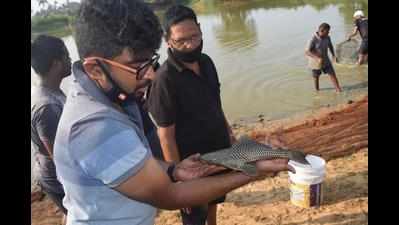Trending
This story is from March 15, 2021
Aquarium fish in Cansaulim ponds may be first such record in Goa
The finding of a large population of an ornamental sucker fish species in a freshwater pond at Cansaulim may be the first report of this aquarium variety breeding in a natural habitat in Goa, scientists said.

With African catfish and Mozambique tilapia already carving out habitats in Goan waters, another threat looms for the declining native fish biodiversity
PANAJI: The finding of a large population of an ornamental sucker fish species in a freshwater pond at Cansaulim may be the first report of this aquarium variety breeding in a natural habitat in Goa, scientists said.
Fisheries scientists from Indian Council of Agricultural Research (ICAR), Old Goa, have collected samples of the sucker fish (pterygoplichthys) from the rejects near the pond where a study on the dynamics of another invasive species entering Goan waters is underway.
“We are analysing the samples and that will help us understand and assess how exotic fish invasion is affecting our inland waters,” ICAR fisheries scientist G B Sreekanth said.
TOI had reported on March 9 how posts by animal rescuer Johnson Stephen on the presence of sucker fish in a pond at Cansaulim had alerted scientists. The popular aquarium species has turned out to be a major threat to local fish species and ecosystems in Kerala. With African catfish and Mozambique tilapia already carving out habitats in Goan waters, another threat looms for the declining native fish biodiversity.
The locals first spotted the sucker fish in fields during monsoon overflow. “It was about three to four years ago, and may have possibly come from the nearby river,” a local resident Neville Saldanha said.
Locals and scientists are apprehensive even as invasive species remain an unexplored subject in Goa. “It is a matter of immediate concern and scientific investigation is needed for measures to avoid its further invasion It feeds both on smaller fishes, including frogs and algae,” well-known fisheries scientist Baban Ingole said.
Fisheries scientists from Indian Council of Agricultural Research (ICAR), Old Goa, have collected samples of the sucker fish (pterygoplichthys) from the rejects near the pond where a study on the dynamics of another invasive species entering Goan waters is underway.
“We are analysing the samples and that will help us understand and assess how exotic fish invasion is affecting our inland waters,” ICAR fisheries scientist G B Sreekanth said.
TOI had reported on March 9 how posts by animal rescuer Johnson Stephen on the presence of sucker fish in a pond at Cansaulim had alerted scientists. The popular aquarium species has turned out to be a major threat to local fish species and ecosystems in Kerala. With African catfish and Mozambique tilapia already carving out habitats in Goan waters, another threat looms for the declining native fish biodiversity.
In the Cansaulim pond itself, the catch indicated an alarming presence of the exotic invasive species. “The sucker fish, which we throw out as rejects, is more than 30%. The major haul is of tilapia, and in some ponds of African catfish, both to the extent of 70%,” a local resident Honorato Saldanha said.
The locals first spotted the sucker fish in fields during monsoon overflow. “It was about three to four years ago, and may have possibly come from the nearby river,” a local resident Neville Saldanha said.
Locals and scientists are apprehensive even as invasive species remain an unexplored subject in Goa. “It is a matter of immediate concern and scientific investigation is needed for measures to avoid its further invasion It feeds both on smaller fishes, including frogs and algae,” well-known fisheries scientist Baban Ingole said.
End of Article
FOLLOW US ON SOCIAL MEDIA











